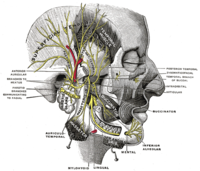
Photo from wikipedia
The aim of this study was to evaluate the effect of juvenile idiopathic arthritis (JIA) on the activity of masticatory muscles using surface electromyography (sEMG). Forty-one JIA subjects (ten males,… Click to show full abstract
The aim of this study was to evaluate the effect of juvenile idiopathic arthritis (JIA) on the activity of masticatory muscles using surface electromyography (sEMG). Forty-one JIA subjects (ten males, thirty-one females; average age 13 years ± 3) and thirty-two healthy control subjects (twenty-seven females, five males; average age 14 years ± 2) were recruited. sEMG of anterior temporalis (TA), masseter (MM), and sternocleidomastoid (SCM) muscles was performed by using the occlusal contact analyzer software called Teethan (BTS S.p.A., Garbagnate Milanese, Milan, Italy). Comparisons between groups were assessed with unpaired t-tests for non-normally distributed data and with Mann–Whitney U tests for normally distributed parameters. The JIA group showed a significant increased percentage overlapping coefficient of TA (POC TA) (p = 0.01) and impact index (IMP) (p = 0.003). No significant differences were observed for the POC MM, POC SCM, percentage overlapping coefficient between posterior and anterior teeth contact (BAR), the torsion index (TORS), and the asymmetry index (ASIM). Masticatory muscles seemed to be slightly affected by JIA. sEMG could be an effective aid in the early clinical detection of TMJ involvement in JIA. Further research is needed to confirm its validity.
Journal Title: Symmetry
Year Published: 2022
Link to full text (if available)
Share on Social Media: Sign Up to like & get
recommendations!